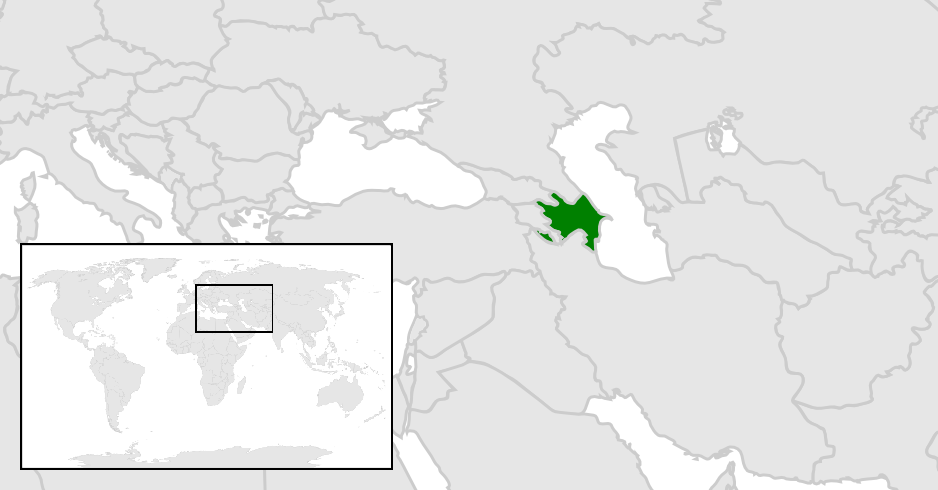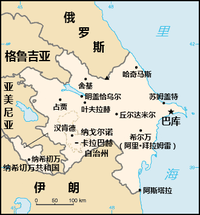This is an old revision of this page, as edited by Tabib (talk | contribs) at 12:26, 24 January 2005. The present address (URL) is a permanent link to this revision, which may differ significantly from the current revision.
Revision as of 12:26, 24 January 2005 by Tabib (talk | contribs)(diff) ← Previous revision | Latest revision (diff) | Newer revision → (diff) For other uses, see Azerbaijan (disambiguation).Azerbaijan (Azerbaijani: Azərbaycan or Азәрбајҹан) is a country in the Caucasus with an east coast on the Caspian Sea. It borders Russia in the north, Georgia, Armenia, in the west and Iran in the south. The Nakhchivan Autonomous Republic (an exclave) borders on Armenia, Iran, and Turkey. It has been a member of the Council of Europe since 2001. The country is an emerging democracy and is formally named the Republic of Azerbaijan (Azerbaijani: Azərbaycan Respublikası)
| |||||
| National motto: None | |||||

| |||||
| Official language | Azerbaijani | ||||
| Capital | Baku | ||||
| Capital's coordinates | 40° 22' N, 49° 53' E | ||||
| President | Ilham Aliyev | ||||
| Prime Minister | Artur Rasizade | ||||
| Area - Total - % water |
Ranked 111th 86,600 km² Negligible | ||||
| Population - Total (July 2004 E) - Density |
Ranked 89th 7,868,385 90/km². | ||||
| Independence - Date |
From Soviet Union 30 August 1991 | ||||
| Currency | Manat (AZM) | ||||
| Time zone | UTC +4 (DST +5) | ||||
| National anthem | National Anthem of the Republic of Azerbaijan | ||||
| Internet TLD | .az | ||||
| Calling Code | 994 | ||||
Origin and history of the name
The original name for the region was Aran. Russians merged the three Persian provinces of Aran, Shervan, and Talish-i Gushtasbi which they had captured some years earlier and named this newly created entity after the Persian province of Azarbaijan, lying south of the river Aras. This was done in order to facilitate future claims by the Russians on the northern Iranian territories.
The name Azerbaijan comes from Atropates ("fire protector" in Middle Persian) who was the independent Iranian satrap at the time of the Seleucids. The region was known as Media Atropatia or Atropatene at the time.
There are also minority opinions that the term is either a slight Turkification of Azarbaijan which is in turn an Arabized version of the original Persian name Azarpayagan, made up of azar+payag+an (azar=fire; payag=base; an=suffix of location); that it traditionally means "the land of eternal flames" or "the land of fire"; or that it is made of four Azerbaijani components: az+er+bay+can which means "the land of the brave Az people" or "an elevated place for the wealthy and exalted". However, these claims are not specifically supported by concrete scholarly and historical evidence.
History
Main article: History of Azerbaijan
Historically, what is today known as the "Republic of Azerbaijan" used to be part of Persia. Persia lost much territory to Russia in the first half of the 18th century in the Caucasus, including all of what is now Republic of Azerbaijan. It is important to note however, that the lost Iranian territories were not just one single Iranian province, rather, they were multiple smaller provinces, most notably Arran (also known as Caucasian Albania), Shervan, Nakhjavan, and Talish-i Gushtasbi. The Iranian province of Azarbaijan (see Iranian Azarbaijan) has always been to the south of the Aras river, as recorded in all the major encyclopedias of the world before 1918. It was only after the end of World War I that the land known as Republic of Azerbaijan today, was for the first time in history named Azerbaijan by the new government formed by the Ottoman-friendly new independent government.
Alternatively, some people claim that there had once existed a "united kingdom of Azerbaijan", made of current Republic of Azerbaijan and the Iranian Azarbaijan region (which they call South Azerbaijan), and that the current Republic of Azerbaijan is the northern part of that "historic kingdom". They usually don't mention any dates for when such a united kingdom existed, but they refer to a Bal'ami History written in the 10th century, pointing to statements that they say mention that all the lands between Derbent and Hamadan are called Azerbaijan and that they "belong to Turks". Critics of this viewpoint note that the aforementioned "statements" in the Bal'ami History do not exist in its source, Tabari History, and that makes their validity doubtful. They also mention that before early twentieth century, most historians and writers have used Azarbaijan/Azerbaijan only as the name of the region south of the Aras River.
Historically, the Persian province of Azerbaijan entirely lied within the limits of modern day Iran and was inhabited by Persian speaking populations. The invading Turks, gradually assimilated and replaced the Natives; also, invading surrounding lands.
Azerbaijan has been an independent republic since the collapse of the Soviet Union in 1991. Despite a cease-fire, in place since 1994, Azerbaijan has yet to resolve its conflict with Armenia over the Azerbaijani Nagorno-Karabakh enclave (largely Armenian populated). Azerbaijan has lost 16% of its territory and must support some 800,000 refugees and internally displaced persons as a result of the conflict.
Politics
Main article: Politics of Azerbaijan
Azerbaijan is a presidential republic. The head of state and head of government are separate from the country's law making body. The people elect the president for a five-year term of office. The president appoints all cabinet level government administrators. A fifty member national assembly makes the country's laws. The people of Azerbaijan elect the National Assembly. Azerbaijan has universal suffrage above the age of eighteen. However, the Azerbaijani government has been accused of widespread corruption (a kleptocracy, to some people).
Administrative divisions
Main article: Administrative divisions of Azerbaijan
Azerbaijan is divided into:
- 59 rayons (rayonlar; rayon - singular),
- 11 cities* (şəhərlər; şəhər - singular),
- 1 autonomous republic** (muxtar respublika);
Abseron Rayonu, Agcabadi Rayonu, Agdam Rayonu, Agdas Rayonu, Agstafa Rayonu, Agsu Rayonu, Ali Bayramli Sahari*, Astara Rayonu, Baki Sahari*, Balakan Rayonu, Barda Rayonu, Beylaqan Rayonu, Bilasuvar Rayonu, Cabrayil Rayonu, Calilabad Rayonu, Daskasan Rayonu, Davaci Rayonu, Fuzuli Rayonu, Gadabay Rayonu, Ganca Sahari*, Goranboy Rayonu, Goycay Rayonu, Haciqabul Rayonu, Imisli Rayonu, Ismayilli Rayonu, Kalbacar Rayonu, Kurdamir Rayonu, Lacin Rayonu, Lankaran Rayonu, Lankaran Sahari*, Lerik Rayonu, Masalli Rayonu, Mingacevir Sahari*, Naftalan Sahari*, Naxcivan Muxtar Respublikasi**, Neftcala Rayonu, Oguz Rayonu, Qabala Rayonu, Qax Rayonu, Qazax Rayonu, Qobustan Rayonu, Quba Rayonu, Qubadli Rayonu, Qusar Rayonu, Saatli Rayonu, Sabirabad Rayonu, Saki Rayonu, Saki Sahari*, Salyan Rayonu, Samaxi Rayonu, Samkir Rayonu, Samux Rayonu, Siyazan Rayonu, Sumqayit Sahari*, Susa Rayonu, Susa Sahari*, Tartar Rayonu, Tovuz Rayonu, Ucar Rayonu, Xacmaz Rayonu, Xankandi Sahari*, Xanlar Rayonu, Xizi Rayonu, Xocali Rayonu, Xocavand Rayonu, Yardimli Rayonu, Yevlax Rayonu, Yevlax Sahari*, Zangilan Rayonu, Zaqatala Rayonu, Zardab Rayonu.
Geography

Main article: Geography of Azerbaijan
Azerbaijan has a temperate climate. Temperatures vary by season. In the southeast lowland, temperatures average forty degrees (Fahrenheit) in the winter and eighty degrees in the summer. In the northern and western mountain ranges, temperatures average fifty-five degrees in the summer and twenty degrees in the winter.
Economy
Main article: Economy of Azerbaijan
The economy is largely based on industry. Industries include machine building, oil and other mining, petroleum refining, textile production, and chemical processing. Agriculture accounts for one third of Azerbaijan's economy. Most of the nation's farms are irrigated. In the lowlands, farmers grow such crops as cotton, fruit, grain, tea, tobacco, and many types of vegetables. Silkworms are raised for production of natural silk for the clothing industry. Azerbaijan's herders raise cattle, sheep and goats near the mountain ranges. Seafood and fish are caught in the nearby Caspian Sea. Azerbaijan is a highly dynamic economy, mainly because of oil, and has a GDP growth of 14% a year.
Demographics
Main article: Demographics of Azerbaijan
According to the CIA World Factbook, about eighty nine percent of Azerbaijan's population is ethnic Azerbaijani, and the rest of the population is Russian, Armenian, or another ethnicity of the area. Some people state that there are also large Talishi and Tat minorities, about thirty percent of the population together, whose existence is either denied (they are counted as Azerbaijanis) or their numbers are downplayed in the official anouncements of the government. Most Azerbaijanis are Shia Muslim. Other religions or philosophical beliefs that are followed by many in the country are the Sunni and Sufi sects of Islam, the Armenian Orthodox Church, the Russian Orthodox Church, and various secular beliefs (much of which are left over from the Soviet era of less tolerance for spirituality).
Culture
Main article: Culture of Azerbaijan
Miscellaneous topics
- Communications in Azerbaijan
- Transportation in Azerbaijan
- Military of Azerbaijan
- Foreign relations of Azerbaijan
- Public holidays in Azerbaijan
- List of Azerbaijanis
- Nagorno-Karabakh
External links and references
- Much of the material in these articles comes from the CIA World Factbook 2000 and the 2003 U.S. Department of State website.
- Caucaz.com : Weekly online publishing articles and reports about Azerbaijan and South Caucasus. Available in English and French
- Baku Today
- State Statistical Committee of the Azerbaijan Republic
- Azerbaijan Pictures
- Who is Who in Azerbaijan
- United Nations Office in Azerbaijan with a country report
- Library of Congress Portals on the World - Azerbaijan
- Azerbaijan: Delivering Dreams
| Commonwealth of Independent States (CIS) | |||||||||||
|---|---|---|---|---|---|---|---|---|---|---|---|
| |||||||||||
| "Participants" (11) |
| ||||||||||
| Sports | |||||||||||
| Military | |||||||||||
| Economics | |||||||||||
| Organization | |||||||||||
| Outside the CIS framework |
| ||||||||||